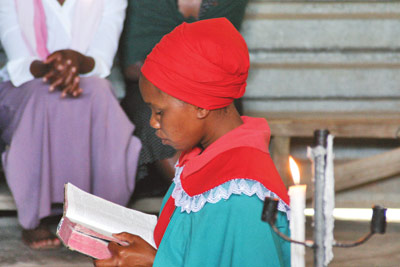How much of your worship service is spent reading and hearing Scripture? 10 percent? 15 percent? More? Less?
In 2004, my doctoral thesis advisor, Constance Cherry, who teaches worship and Christian ministries at Indiana Wesleyan University, surveyed a wide variety of churches in the U.S. to see how much time was spent reading Scripture during worship. She discovered that in traditional, contemporary and “blended” churches, only 5 percent or less of the service was spent reading the Word of God. In most congregations, significantly more time was taken for announcements than for Scripture reading.
Granted, this was a study of American congregations. But I suspect a study of Canadian churches would look quite similar.
A history of reverence for the Bible
Throughout history, the reading and hearing of God’s Word has been an integral part of Christian worship. Early worshipping communities seemingly couldn’t get enough of hearing Scripture. In one of the earliest descriptions of Christian worship (155 A.D.) we read that “the memoirs of the apostles or the writings of the prophets are read, as long as time permits.” By the beginning of the seventh century, a listing of suggested Scripture readings for each worship service (known as a lectionary) had been established.
The great Reform movements of the 16th century sought to keep Scripture at the very heart of the church’s life and worship. Lengthy Bible readings—often a chapter or two at a time—were part of every worship service. Some churches even provided a running commentary alongside the readings, so that people could understand what was being read.
Tremendous reverence and respect for Scripture was demonstrated in many different ways: through the careful selection of gifted readers; in the reverent way in which biblical texts were handled in worship; in the spoken and sung congregational responses before and after the Word was read; even in the beauty with which Scripture was copied and illustrated.
The reading of Scripture in worship was understood to be much more than just the sharing of information. There was a clear expectation that, when the Word was read, God was again speaking to the gathered community.
Is this how you experience the reading of Scripture in worship? Do you find yourself listening eagerly and expectantly, anticipating a word from God?
Reviving the practice
If your congregation is interested in strengthening the reading and hearing of Scripture in worship, here are a few ideas you might consider.
• Pray before the reading of Scripture. Throughout history, congregations have prayed for the active presence of the Holy Spirit before Scripture is read. Traditionally, a prayer before the reading and preaching of the Word was called a prayer of illumination. A prayer like this reminds us that we are dependent upon the leading and guiding of the Holy Spirit if we are to hear the Word that God has for us.
• Use more Scripture. Instead of limiting the Scripture reading to the sermon text alone—as is the case in many congregations—consider using multiple texts throughout the service. Whether you follow the Revised Common Lectionary or devise your own reading plan, increasing the number of readings and their placement in the service can greatly enhance your opportunity to hear God’s voice.
There are many places where Scripture texts can enrich worship: in a call to worship (Psalm 100); an invitation to praise (Psalm 33:1-4); a prayer of thanksgiving (Ephesians 1:3-14); an invitation to the offering (Psalm 116:17-18); a prayer of lament (Psalm 12) or confession (Psalm 51); the assurance of God’s forgiveness following confession (Romans 8:1-2); a call to prayer (Psalm 55:16-17); the blessing of God as we leave (Numbers 6:24-26). Some congregations make a point of including a spoken or sung psalm in every service.
Reading the same passage of Scripture more than once in the same service can be very meaningful. Using different voices and translations can help us hear the passage in new ways. An entire worship service can even be built around a single passage, exploring it textually, musically, dramatically and visually.
• Use a variety of voices—young and old; men, women and children; newcomers and life-long believers. What better way to illustrate that the Word of God belongs to the whole congregation?
• Encourage and equip readers to read well. As is the case with other public ministries in worship, those who read Scripture should possess some natural gifts and be willing to work at improving their public reading skills.
Rather than being handed readings at the last minute, readers should be given a chance to study the texts and prepare them carefully in advance.
Some churches put together a list of guidelines to help readers in their preparation; others have found it helpful to create a readers group, in which individuals can receive feedback and encouragement in a smaller setting.
Two books that can help are Jack Hartjes’s Read the Way You Talk (Liturgical Press) or Aelred Rosser’s A Well-Trained Tongue (Liturgy Training Publications).
• Use drama. In 2001, Wanda Vassallo, a D.Min. student at McMaster Divinity College in Hamilton, Ont., studied the effect of adding drama to Scripture readings. She discovered that people remembered and responded to Scripture readings much better when they were acted out in some way than when they were simply read.
Not all Scripture passages lend themselves to dramatic presentation, but many do. Costumes and sets are not always required; a simple readers theatre approach can also be effective. Michael Perry’s The Dramatised Bible (recently republished by HarperCollins) does a wonderful job of presenting Scripture in a readers theatre approach.
• Interpret texts visually. While we continue to value print and oral media, we live in an increasingly visual culture. Why not consider adding a visual component to Scripture readings? If your church is set up for video projection, you can easily access a wide range of traditional and contemporary art on biblical themes. (Make sure you get permission if it is copyrighted.)
A website like The Text This Week (textweek.com) offers a wonderful index of online artwork linked to scriptural passages and topics. You might also explore the use of video; The Work of the People (TheWorkOfThePeople.com), for example, offers thoughtful video clips and is searchable by keyword or lectionary date.
• Sing Scripture. Many of the hymns and songs we sing are scripturally based. Some are metrical settings of complete scriptural texts; others are paraphrases or clearly allude to biblical events or teaching.
Acknowledging the scriptural basis of the songs we sing—either verbally or in print—is a good way to highlight Scripture during worship. Churches that use bulletins can simply note the scriptural source beside the song title in the worship order. For example: “Praise, My Soul, the King of Heaven” (Psalm 103). If you use video projection, it’s easy to simply note the relevant scriptural text on the first slide.
If you use hymnals, you can take advantage of the “Scriptural allusions and references” index at the back to help you find songs to match the day’s readings. If you sing more contemporary styles of music, you may need to do a bit more research on your own; while much praise and worship music is deeply scriptural, accessing scriptural references is not yet quite as easy.
• Allow Scripture to shape prayer. That is, allow the images and substance of scriptural passages to enrich the content and shape of your corporate prayer—what Russell Mitman in Worship in the Shape of Scripture (The Pilgrim Press) calls “the art of transposition.” If you are interested in exploring how Scripture can help shape worship leading, check out Mitman’s chapter on “Transposing the texts.”
Another wonderful source for learning to praying biblically is Laurence Hull Stookey’s Let the Whole Church Say Amen! A Guide for Those Who Pray in Public (Abingdon Press).
• Listen attentively, and with anticipation. The writer of Hebrews tells us that the Word of God is “living and active. Sharper than any double-edged sword, it penetrates even to dividing soul and spirit, joints and marrow; it judges the thoughts and attitudes of the heart” (Hebrews 4:12).
The Word we proclaim in worship is not merely a record of how God once intervened in history—it is a living continuation of that intervention. Those who read Scripture in worship are not merely teachers conveying information about God. Rather, they are the vehicle through which God’s Word comes to life again in the presence of the gathered people.
The last word
Aelred Rosser, author of A Well-Trained Tongue, once wrote: “The Word of God is not a history lesson, though there is history in it. The Word is not a story, though it is full of stories. It is not a set of rules to live by, though there is much in it to guide our choices. No, the Word of God is a living and dynamic presence, achieving the very salvation about which it speaks even as the reader proclaims it.”









Leave a Reply
You must be logged in to post a comment.